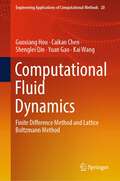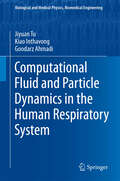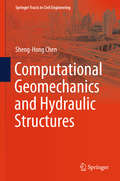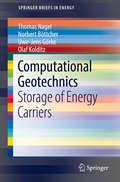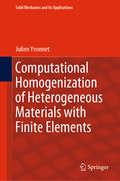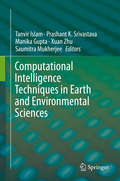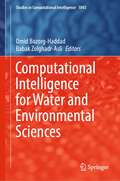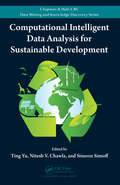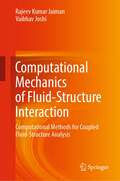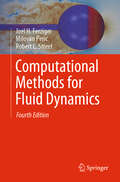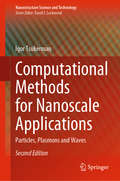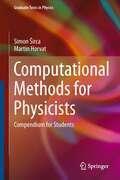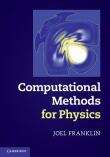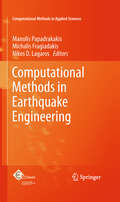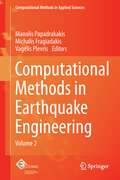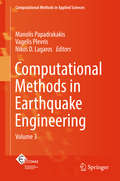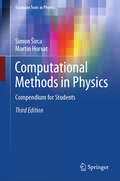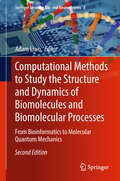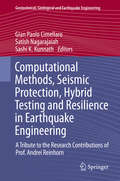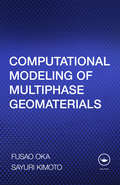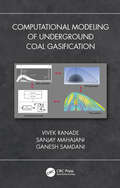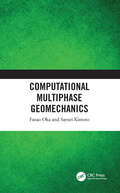- Table View
- List View
Computational Fluid Dynamics: Finite Difference Method and Lattice Boltzmann Method (Engineering Applications of Computational Methods #20)
by Yuan Gao Kai Wang Guoxiang Hou Caikan Chen Shenglei QinThis book provides a concise and comprehensive introduction to several basic methods with more attention to their theoretical basis and applications in fluid dynamics. Furthermore, some new ideas are presented in this book, for example, a method to solve the transition matrix by difference operator transformation. For this method, the book gives the definition of Fourier integral transformation of translation operator, and proves the transition matrix equaling to the differential operator transformation, so that it is extended to general situations of explicit, implicit, multi-layer difference equations, etc. This flexible approach is also used in the differential part. In addition, the book also includes six types of equivalent stability definitions in two ways and deeply analyzes their errors, stabilities and convergences of the difference equations. What is more important, some new scientific contributions on lattice Boltzmann method (LBM) in recent years are presented in the book as well. The authors write the book combining their ten years teaching experience and research results and this book is intended for graduate students who are interested in the area of computational fluid dynamics (CFD). Authors list some new research achievements, such as simplified lattice Boltzmann method, the simplified lattice Boltzmann flux solver and discrete unified gas kinetic scheme, and expect that this new information could give readers possible further investigating ideas in their future research on CFD area.
Computational Fluid and Particle Dynamics in the Human Respiratory System (Biological and Medical Physics, Biomedical Engineering)
by Goodarz Ahmadi Jiyuan Tu Kiao InthavongTraditional research methodologies in the human respiratory system have always been challenging due to their invasive nature. Recent advances in medical imaging and computational fluid dynamics (CFD) have accelerated this research. This book compiles and details recent advances in the modelling of the respiratory system for researchers, engineers, scientists, and health practitioners. It breaks down the complexities of this field and provides both students and scientists with an introduction and starting point to the physiology of the respiratory system, fluid dynamics and advanced CFD modeling tools. In addition to a brief introduction to the physics of the respiratory system and an overview of computational methods, the book contains best-practice guidelines for establishing high-quality computational models and simulations. Inspiration for new simulations can be gained through innovative case studies as well as hands-on practice using pre-made computational code. Last but not least, students and researchers are presented the latest biomedical research activities, and the computational visualizations will enhance their understanding of physiological functions of the respiratory system.
Computational Geomechanics and Hydraulic Structures (Springer Tracts in Civil Engineering)
by Sheng-Hong ChenThis book presents recent research into developing and applying computational tools to estimate the performance and safety of hydraulic structures from the planning and construction stage to the service period. Based on the results of a close collaboration between the author and his colleagues, friends, students and field engineers, it shows how to achieve a good correlation between numerical computation and the actual in situ behavior of hydraulic structures. The book’s heuristic and visualized style disseminates the philosophy and road map as well as the findings of the research. The chapters reflect the various aspects of the three typical and practical methods (the finite element method, the block element method, the composite element method) that the author has been working on and made essential contributions to since the 1980s. This book is an advanced continuation of Hydraulic Structures by the same author, published by Springer in 2015.
Computational Geotechnics: Storage of Energy Carriers (SpringerBriefs in Energy)
by Thomas Nagel Norbert Böttcher Uwe-Jens Görke Olaf KolditzIn this book, effective computational methods to facilitate those pivotal simulations using open-source software are introduced and discussed with a special focus on the coupled thermo-mechanical behavior of the rock salt. A cohesive coverage of applying geotechnical modeling to the subsurface storage of hydrogen produced from renewable energy sources is accompanied by specific, reproducible example simulations to provide the reader with direct access to this fascinating and important field. Energy carriers such as natural gas, hydrogen, oil, and even compressed air can be stored in subsurface geological formations such as depleted oil or gas reservoirs, aquifers, and caverns in salt rock. Many challenges have arisen in the design, safety and environmental impact assessment of such systems, not the least of which is that large-scale experimentation is not a feasible option. Therefore, simulation techniques are central to the design and risk assessment of these and similar geotechnical facilities.
Computational Homogenization of Heterogeneous Materials with Finite Elements (Solid Mechanics and Its Applications #258)
by Julien YvonnetThis monograph provides a concise overview of the main theoretical and numerical tools to solve homogenization problems in solids with finite elements. Starting from simple cases (linear thermal case) the problems are progressively complexified to finish with nonlinear problems. The book is not an overview of current research in that field, but a course book, and summarizes established knowledge in this area such that students or researchers who would like to start working on this subject will acquire the basics without any preliminary knowledge about homogenization. More specifically, the book is written with the objective of practical implementation of the methodologies in simple programs such as Matlab. The presentation is kept at a level where no deep mathematics are required.
Computational Intelligence Techniques in Earth and Environmental Sciences
by Saumitra Mukherjee Xuan Zhu Tanvir Islam Prashant K. Srivastava Manika GuptaComputational intelligence techniques have enjoyed growing interest in recent decades among the earth and environmental science research communities for their powerful ability to solve and understand various complex problems and develop novel approaches toward a sustainable earth. This book compiles a collection of recent developments and rigorous applications of computational intelligence in these disciplines. Techniques covered include artificial neural networks, support vector machines, fuzzy logic, decision-making algorithms, supervised and unsupervised classification algorithms, probabilistic computing, hybrid methods and morphic computing. Further topics given treatment in this volume include remote sensing, meteorology, atmospheric and oceanic modeling, climate change, environmental engineering and management, catastrophic natural hazards, air and environmental pollution and water quality. By linking computational intelligence techniques with earth and environmental science oriented problems, this book promotes synergistic activities among scientists and technicians working in areas such as data mining and machine learning. We believe that a diverse group of academics, scientists, environmentalists, meteorologists and computing experts with a common interest in computational intelligence techniques within the earth and environmental sciences will find this book to be of great value.
Computational Intelligence for Water and Environmental Sciences (Studies in Computational Intelligence #1043)
by Omid Bozorg-Haddad Babak Zolghadr-AsliThis book provides a comprehensive yet fresh perspective for the cutting-edge CI-oriented approaches in water resources planning and management. The book takes a deep dive into topics like meta-heuristic evolutionary optimization algorithms (e.g., GA, PSA, etc.), data mining techniques (e.g., SVM, ANN, etc.), probabilistic and Bayesian-oriented frameworks, fuzzy logic, AI, deep learning, and expert systems. These approaches provide a practical approach to understand and resolve complicated and intertwined real-world problems that often imposed serious challenges to traditional deterministic precise frameworks. The topic caters to postgraduate students and senior researchers who are interested in computational intelligence approach to issues stemming from water and environmental sciences.
Computational Intelligent Data Analysis for Sustainable Development (Chapman & Hall/CRC Data Mining and Knowledge Discovery Series)
by Ting Yu Simeon Simoff Nitesh V. ChawlaGoing beyond performing simple analyses, researchers involved in the highly dynamic field of computational intelligent data analysis design algorithms that solve increasingly complex data problems in changing environments, including economic, environmental, and social data. Computational Intelligent Data Analysis for Sustainable Development present
Computational Mechanics of Fluid-Structure Interaction: Computational Methods for Coupled Fluid-Structure Analysis
by Rajeev Kumar Jaiman Vaibhav JoshiThis book is intended to provide a compilation of the state-of-the-art numerical methods for nonlinear fluid-structure interaction using the moving boundary Lagrangian-Eulerian formulation. Single and two-phase viscous incompressible fluid flows are considered with the increasing complexity of structures ranging from rigid-body, linear elastic and nonlinear large deformation to fully-coupled flexible multibody system. This book is unique with regard to computational modeling of such complex fluid-structure interaction problems at high Reynolds numbers, whereby various coupling techniques are introduced and systematically discussed. The techniques are demonstrated for large-scale practical problems in aerospace and marine/offshore engineering. This book also provides a comprehensive understanding of underlying unsteady physics and coupled mechanical aspects of the fluid-structure interaction from a computational point of view. Using the body-fitted and moving mesh formulations, the physical insights associated with structure-to-fluid mass ratios (i.e., added mass effects), Reynolds number, large structural deformation, free surface, and other interacting physical fields are covered. The book includes the basic tools necessary to build the concepts required for modeling such coupled fluid-structure interaction problems, thus exposing the reader to advanced topics of multiphysics and multiscale phenomena.
Computational Methods and Mathematical Modeling in Cyberphysics and Engineering Applications 1
by Nikolaos Limnios Dmitri Koroliouk Sergiy LyashkoMathematical methods in engineering are characterized by a wide range of techniques for approaching various problems. Moreover, completely different analysis techniques can be applied to the same problem, which is justified by the difference in specific applications. Therefore, the study of the analyses and solutions of specific problems leads the researcher to generate their own techniques for the analysis of similar problems continuously arising in the process of technical development. Computational Methods and Mathematical Modeling in Cyberphysics and Engineering Applications contains solutions to specific problems in current areas of computational engineering and cyberphysics.
Computational Methods for Fluid Dynamics
by Joel H. Ferziger Milovan Perić Robert L. StreetThis book is a guide to numerical methods for solving fluid dynamics problems. The most widely used discretization and solution methods, which are also found in most commercial CFD-programs, are described in detail. Some advanced topics, like moving grids, simulation of turbulence, computation of free-surface flows, multigrid methods and parallel computing, are also covered. Since CFD is a very broad field, we provide fundamental methods and ideas, with some illustrative examples, upon which more advanced techniques are built. Numerical accuracy and estimation of errors are important aspects and are discussed in many examples. Computer codes that include many of the methods described in the book can be obtained online. This 4th edition includes major revision of all chapters; some new methods are described and references to more recent publications with new approaches are included. Former Chapter 7 on solution of the Navier-Stokes equations has been split into two Chapters to allow for a more detailed description of several variants of the Fractional Step Method and a comparison with SIMPLE-like approaches. In Chapters 7 to 13, most examples have been replaced or recomputed, and hints regarding practical applications are made. Several new sections have been added, to cover, e.g., immersed-boundary methods, overset grids methods, fluid-structure interaction and conjugate heat transfer.
Computational Methods for Nanoscale Applications: Particles, Plasmons and Waves (Nanostructure Science and Technology)
by Igor TsukermanPositioning itself at the common boundaries of several disciplines, this work provides new perspectives on modern nanoscale problems where fundamental science meets technology and computer modeling. In addition to well-known computational techniques such as finite-difference schemes and Ewald summation, the book presents a new finite-difference calculus of Flexible Local Approximation Methods (FLAME) that qualitatively improves the numerical accuracy in a variety of problems.
Computational Methods for Physicists: Compendium for Students (Graduate Texts in Physics)
by Simon Sirca Martin HorvatThis book helps advanced undergraduate, graduate and postdoctoral students in their daily work by offering them a compendium of numerical methods. The choice of methods pays significant attention to error estimates, stability and convergence issues as well as to the ways to optimize program execution speeds. Many examples are given throughout the chapters, and each chapter is followed by at least a handful of more comprehensive problems which may be dealt with, for example, on a weekly basis in a one- or two-semester course. In these end-of-chapter problems the physics background is pronounced, and the main text preceding them is intended as an introduction or as a later reference. Less stress is given to the explanation of individual algorithms. It is tried to induce in the reader an own independent thinking and a certain amount of scepticism and scrutiny instead of blindly following readily available commercial tools.
Computational Methods for Physics
by Joel FranklinThere is an increasing need for undergraduate students in physics to have a core set of computational tools. Most problems in physics benefit from numerical methods, and many of them resist analytical solution altogether. This textbook presents numerical techniques for solving familiar physical problems where a complete solution is inaccessible using traditional mathematical methods. The numerical techniques for solving the problems are clearly laid out, with a focus on the logic and applicability of the method. The same problems are revisited multiple times using different numerical techniques, so readers can easily compare the methods. The book features over 250 end-of-chapter exercises. A website hosted by the author features a complete set of programs used to generate the examples and figures, which can be used as a starting point for further investigation. A link to this can be found at www. cambridge. org/9781107034303.
Computational Methods in Earthquake Engineering: Volume 2 (Computational Methods in Applied Sciences #21)
by Manolis Papadrakakis Nikos D. Lagaros Michalis FragiadakisThis book provides an insight in advanced methods and concepts for structural analysis and design against seismic loading. The book consists of 25 chapters dealing with a wide range of timely issues in contemporary Earthquake Engineering. In brief, the topics covered are: collapse assessment, record selection, effect of soil conditions, problems in seismic design, protection of monuments, earth dam structures and liquid containers, numerical methods, lifetime assessment, post-earthquake measures. A common ground of understanding is provided between the communities of Earth Sciences and Computational Mechanics towards mitigating seismic risk. The topic is of great social and scientific interest, due to the large number of scientists and practicing engineers currently working in the field and due to the great social and economic consequences of earthquakes.
Computational Methods in Earthquake Engineering: Volume 2 (Computational Methods in Applied Sciences #30)
by Manolis Papadrakakis Michalis Fragiadakis Vagelis PlevrisThis book provides an insight on advanced methods and concepts for the design and analysis of structures against earthquake loading. This second volume is a collection of 28 chapters written by leading experts in the field of structural analysis and earthquake engineering. Emphasis is given on current state-of-the-art methods and concepts in computing methods and their application in engineering practice. The book content is suitable for both practicing engineers and academics, covering a wide variety of topics in an effort to assist the timely dissemination of research findings for the mitigation of seismic risk. Due to the devastating socioeconomic consequences of seismic events, the topic is of great scientific interest and is expected to be of valuable help to scientists and engineers. The chapters of this volume are extended versions of selected papers presented at the COMPDYN 2011 conference, held in the island of Corfu, Greece, under the auspices of the European Community on Computational Methods in Applied Sciences (ECCOMAS).
Computational Methods in Earthquake Engineering: Volume 3 (Computational Methods in Applied Sciences #44)
by Manolis Papadrakakis Nikos D. Lagaros Vagelis PlevrisThis book provides an insight in advanced methods and concepts for structural analysis and design against seismic loading. The book consists of 25 chapters dealing with a wide range of timely issues in contemporary Earthquake Engineering. In brief, the topics covered are: collapse assessment, record selection, effect of soil conditions, problems in seismic design, protection of monuments, earth dam structures and liquid containers, numerical methods, lifetime assessment, post-earthquake measures. A common ground of understanding is provided between the communities of Earth Sciences and Computational Mechanics towards mitigating seismic risk. The topic is of great social and scientific interest, due to the large number of scientists and practicing engineers currently working in the field and due to the great social and economic consequences of earthquakes.
Computational Methods in Physics: Compendium for Students (Graduate Texts in Physics)
by Martin Horvat Simon ŠircaThis book is intended to help advanced undergraduate, graduate, and postdoctoral students in their daily work by offering them a compendium of numerical methods. The choice of methods pays significant attention to error estimates, stability and convergence issues, as well as optimization of program execution speeds. Numerous examples are given throughout the chapters, followed by comprehensive end-of-chapter problems with a more pronounced physics background, while less stress is given to the explanation of individual algorithms. The readers are encouraged to develop a certain amount of skepticism and scrutiny instead of blindly following readily available commercial tools. The second edition has been enriched by a chapter on inverse problems dealing with the solution of integral equations, inverse Sturm-Liouville problems, as well as retrospective and recovery problems for partial differential equations. The revised text now includes an introduction to sparse matrix methods, the solution of matrix equations, and pseudospectra of matrices; it discusses the sparse Fourier, non-uniform Fourier and discrete wavelet transformations, the basics of non-linear regression and the Kolmogorov-Smirnov test; it demonstrates the key concepts in solving stiff differential equations and the asymptotics of Sturm-Liouville eigenvalues and eigenfunctions. Among other updates, it also presents the techniques of state-space reconstruction, methods to calculate the matrix exponential, generate random permutations and compute stable derivatives.
Computational Methods in Physics: Compendium for Students (Graduate Texts in Physics)
by Martin Horvat Simon ŠircaThis textbook provides a compendium of numerical methods to assist physics students and researchers in their daily work. It carefully considers error estimates, stability and convergence issues, the choice of optimal methods, and techniques to increase program execution speeds. The book supplies numerous examples throughout the chapters that are concluded by more comprehensive problems with a strong physics background. Instead of uncritically employing modern black-box tools, the readers are encouraged to develop a more ponderous and skeptical approach. This revised and expanded edition now includes a new chapter on numerical integration and stable differentiation, as well as fresh material on optimal filtering, integration of gravitational many-body problems, computation of Poincaré maps, regularization of orbits, singular Sturm-Liouville problems, techniques for time evolution and spatial treatment of (semi)infinite domains in spectral methods, and phase retrieval. It also brings updated discussions of algebraic problems involving sparse matrices and of high-resolution schemes for partial differential equations.
Computational Methods to Study the Structure and Dynamics of Biomolecules and Biomolecular Processes: From Bioinformatics to Molecular Quantum Mechanics (Springer Series on Bio- and Neurosystems #8)
by Adam LiwoThis book provides a comprehensive overview of modern computer-based techniques for analyzing the structure, properties and dynamics of biomolecules and biomolecular processes. It is organized in four main parts; the first one deals with methodology of molecular simulations; the second one with applications of molecular simulations; the third one introduces bioinformatics methods and the use of experimental information in molecular simulations; the last part reports on selected applications of molecular quantum mechanics. This second edition has been thoroughly revised and updated to include the latest progresses made in the respective field of research.
Computational Methods, Seismic Protection, Hybrid Testing and Resilience in Earthquake Engineering: A Tribute to the Research Contributions of Prof. Andrei Reinhorn (Geotechnical, Geological and Earthquake Engineering #33)
by Gian Paolo Cimellaro Satish Nagarajaiah Sashi K. KunnathThe book is a tribute to the research contribution of Professor Andrei Reinhorn in the field of earthquake engineering. It covers all the aspects connected to earthquake engineering starting from computational methods, hybrid testing and control, resilience and seismic protection which have been the main research topics in the field of earthquake engineering in the last 30 years. These were all investigated by Prof. Reinhorn throughout his career. The book provides the most recent advancements in these four different fields, including contributions coming from six different countries giving an international outlook to the topics.
Computational Modeling of Multiphase Geomaterials
by Fusao Oka Sayuri KimotoComputational Modeling of Multiphase Geomaterials discusses how numerical methods play a very important role in geotechnical engineering and in the related activity of computational geotechnics. It shows how numerical methods and constitutive modeling can help predict the behavior of geomaterials such as soil and rock.After presenting the fundament
Computational Modeling of Underground Coal Gasification
by Vivek V. Ranade Sanjay M Mahajani Ganesh Arunkumar SamdaniThe book deals with development of comprehensive computational models for simulating underground coal gasification (UCG). It starts with an introduction to the UCG process and process modelling inputs in the form of reaction kinetics, flow patterns, spalling rate, and transport coefficient that are elaborated with methods to generate the same are described with illustrations. All the known process models are reviewed, and relative merits and limitations of the modeling approaches are highlighted and compared. The book describes all the necessary steps required to determine the techno-economic feasibility of UCG process for a given coal reserve, through modeling and simulation.
Computational Models for Polydisperse Particulate and Multiphase Systems
by Daniele L. Marchisio Rodney O. FoxProviding a clear description of the theory of polydisperse multiphase flows, with emphasis on the mesoscale modelling approach and its relationship with microscale and macroscale models, this all-inclusive introduction is ideal whether you are working in industry or academia. Theory is linked to practice through discussions of key real-world cases (particle/droplet/bubble coalescence, break-up, nucleation, advection and diffusion and physical- and phase-space), providing valuable experience in simulating systems that can be applied to your own applications. Practical cases of QMOM, DQMOM, CQMOM, EQMOM and ECQMOM are also discussed and compared, as are realizable finite-volume methods. This provides the tools you need to use quadrature-based moment methods, choose from the many available options, and design high-order numerical methods that guarantee realizable moment sets. In addition to the numerous practical examples, MATLAB scripts for several algorithms are also provided, so you can apply the methods described to practical problems straight away.
Computational Multiphase Geomechanics
by Fusao Oka Sayuri KimotoNumerical methods are very powerful tools for use in geotechnical engineering, particularly in computational geotechnics. Interest is strong in the new field of multi-phase nature of geomaterials, and the area of computational geotechnics is expanding. Alongside their companion volume Computational Modeling of Multiphase Geomaterials (CRC Press, 2012), Fusao Oka and Sayuri Kimoto cover recent progress in several key areas, such as air-water-soil mixture, cyclic constitutive models, anisotropic models, noncoaxial models, gradient models, compaction bands (a form of volumetric strain localization and strain localization under dynamic conditions), and the instability of unsaturated soils. The text also includes applications of computational modeling to large-scale excavation of ground, liquefaction analysis of levees during earthquakes, methane hydrate development, and the characteristics of contamination using bentonite. The erosion of embankments due to seepage flow is also presented.
